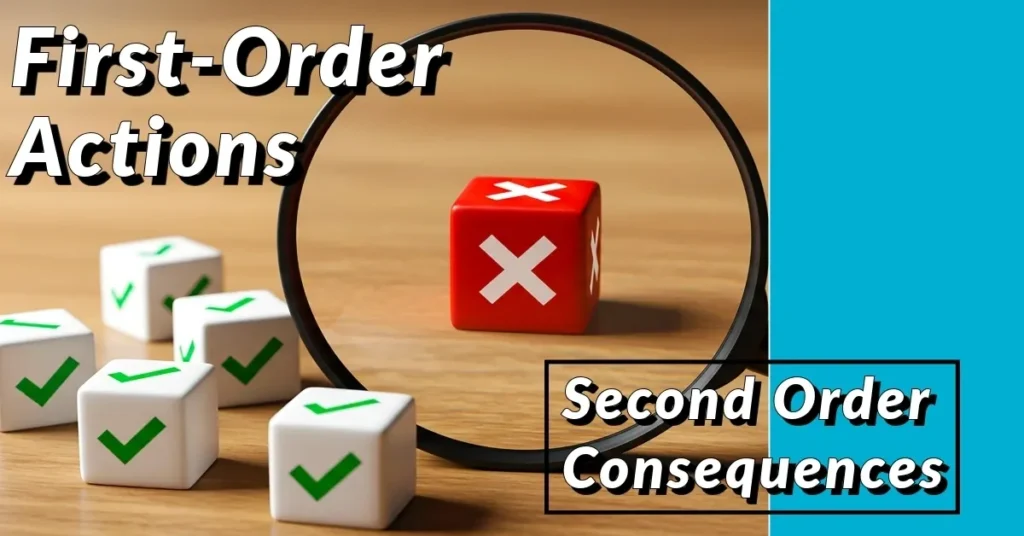How Your Quick Fixes Create Unexpected Bottlenecks
Ray Dalio, celebrated investor and author of Principles, teaches an important lesson about decision-making: to build lasting success, you must differentiate clearly between first-order actions—the immediate steps you take to address urgent problems—and second-order consequences, the longer-term impacts that often aren’t obvious at first glance.
Entrepreneurs and small business owners frequently face situations that demand quick action—these are your first-order actions. They’re often driven by the urgent demands of the moment, such as handling client issues personally or solving operational problems quickly. While these actions solve immediate needs, they frequently lead to second-order consequences—often unforeseen outcomes—that can become serious bottlenecks to your future growth.
This post will help you clearly understand the difference, using practical examples, so you can make smarter, more strategic decisions.
What Are First-Order Actions and Second-Order Consequences?
First-order actions are the decisions or steps you take to immediately resolve a pressing issue. They usually produce a fast result, provide immediate relief, and feel like an obvious solution at the moment. Second-order consequences are the longer-term, ripple-effect outcomes of those actions. They rarely show up immediately, and they’re often subtle at first—but over time, they become critical, sometimes even becoming serious roadblocks. Dalio points out something crucial: the first-order actions you take often have second-order consequences that lead in an opposite direction. What initially looks beneficial can create lasting harm or inefficiencies in your business down the line.
Real-Life Scenario: A Boutique Marketing Agency Owner
Imagine an entrepreneur who runs a growing boutique marketing agency. Initially, they take on all client communication personally. At first glance, this first-order action is hugely positive. Clients feel special, issues are handled promptly, and trust builds quickly. Immediate wins stack up, creating an impression of effectiveness.But over time, this entrepreneur finds themselves overwhelmed by the very action that felt right initially. Now, clients refuse to engage with anyone else, and the business’s growth stalls—because every decision, approval, and conversation flows through the owner. What started as good customer service has unintentionally created a serious operational bottleneck. This is the hidden second-order consequence of their initial first-order action.
Important Clarification: This does not mean small business owners should avoid personal interactions entirely. Indeed, you must strategically choose which key client relationships to own personally to preserve quality, brand trust, and essential strategic partnerships. The goal is thoughtful balance: own essential relationships yourself, while empowering your team through effective processes and clear communication.
Using Second-Order Thinking to Guide Your Actions
To avoid being blindsided by second-order consequences, entrepreneurs need a simple mental framework:
Step 1: Evaluate Your First-Order Actions Clearly
- Ask yourself: “What immediate benefits or relief will this action provide?”
- Recognize the temptation to prioritize quick fixes, particularly under stress.
Step 2: Identify Potential Second-Order Consequences
- Ask yourself: “What longer-term issues might this immediate action create?”
- Think about potential dependency, reduced team autonomy, scalability issues, and other hidden future challenges.
Step 3: Balance Immediate Needs with Long-Term Sustainability
- Consider both immediate actions and their possible future outcomes.
- Reflect carefully: “Are the immediate benefits worth the potential longer-term downsides?”
How Second-Order Thinking Helps Prevent Bottlenecks
Applying this way of thinking proactively helps you avoid future bottlenecks:
- Client Management: Instead of immediately taking on every customer issue yourself (first-order action), document processes and train your team to handle routine interactions. Reserve your personal involvement for high-stakes or strategic relationships.
- Operational Problem-Solving: Rather than stepping in every time an operational issue arises, coach your team through solutions. This action fosters capability and independence, reducing long-term reliance on you.
- Growth and Scalability: Prioritize creating repeatable processes, documented workflows, and automations, allowing your team to replicate results without constant oversight.
Practical Steps for Entrepreneurs
Here’s a practical guide to implementing second-order thinking in your decision-making process:
- Pause and Reflect: Before taking immediate action, take a moment to evaluate potential longer-term impacts.
- Identify Essential Relationships: Clearly decide which key client relationships to “own” personally, while empowering your team to manage other accounts effectively.
- Document Clearly: Create standard operating procedures (SOPs) for common situations, so your team can handle these independently.
- Train and Empower: Clearly communicate expectations and provide your team the tools and training they need to succeed.
- Regularly Review and Adjust: Continually assess decisions and outcomes to catch emerging bottlenecks before they become severe.
Conclusion
Every entrepreneur faces countless situations where immediate action seems essential. While first-order actions are necessary, it’s critical to recognize their potential second-order consequences. Using Ray Dalio’s insight, you can intentionally balance short-term needs with long-term growth.
By proactively applying second-order thinking, you’ll avoid unintended bottlenecks, foster empowered teams, and build sustainable systems. Ultimately, this approach helps your business thrive not just today, but well into the future.
Ready to Apply Second-Order Thinking to Your Business? If you’re feeling stuck dealing with bottlenecks or unsure how to apply strategic second-order thinking, let’s chat.
Schedule a free discovery call and we’ll identify exactly what’s slowing your growth—and how to move past it sustainably.👉 [Schedule Your Discovery Call Today]

